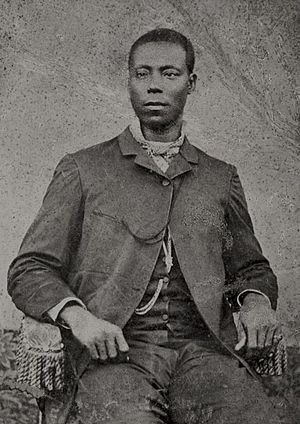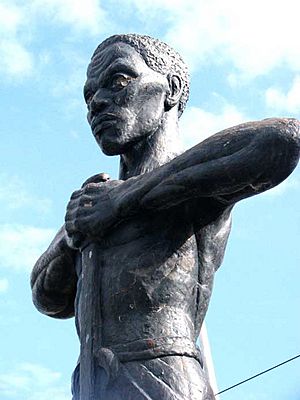Paul Bogle facts for kids
Quick facts for kids
Paul Bogle
ONH
|
|
|---|---|
 |
|
| Born | 1822 |
| Died | October 24, 1865 (aged 42–43) |
| Cause of death | Hanged |
| Nationality | Jamaican |
| Known for | Leader of the protesters in the Morant Bay rebellion |
Paul Bogle (1822– 24 October 1865) was a brave Jamaican leader. He was a Baptist deacon and an activist. He is remembered as a National Hero of Jamaica. In 1865, Paul Bogle led people in the Morant Bay area. They marched to ask for justice and fair treatment. After the Morant Bay rebellion, Bogle was captured. The colonial government found him guilty and he was hanged. This happened on October 24, 1865.
Paul Bogle became friends with George William Gordon. Gordon was a wealthy landowner and also a Baptist. He helped Bogle become a deacon at Stony Gut Baptist Church in 1864. Life was very hard for black peasants in Jamaica. They faced unfair treatment and many problems. These included floods, bad harvests, and sickness. Most people could not vote because they had to pay a special tax.
In August 1865, Gordon spoke out against the governor of Jamaica. The governor was Edward John Eyre. Gordon said Eyre supported unfair actions against black people. Paul Bogle worked hard to make life better for poor people. He wanted to fix the social problems. Bogle led a group of farmers on a long walk. They walked 45 miles to Spanish Town, the capital. They hoped to talk to Governor Eyre about their problems. But they were not allowed to meet him. Because of this, the people of Stony Gut lost trust in the government. More and more people supported Bogle.
The Morant Bay Rebellion
On October 7, 1865, a conflict started in Stony Gut. A black man was found guilty of going onto an old plantation. He was sent to prison. One of Bogle's supporters protested in court. This person was then arrested. This made the crowd very angry. Bogle and his men quickly helped the person escape. They went to the market square and fought back. The police were beaten and had to leave.
On October 9, 1865, arrest warrants were issued for Bogle and others. They were wanted for causing a riot and fighting. Police went to Stony Gut to arrest Bogle. But the people there fought back strongly. The police were forced to go back to Morant Bay.
A few days later, on October 11, 1865, a meeting was held. Bogle led hundreds of his followers to the Court House. They carried sticks and machetes. The authorities had gathered a volunteer army. When stones were thrown, the army fired into the crowd. Seven men were killed. The protesters then set fire to the Court House and other buildings. When officials tried to leave, many were killed by the angry crowd. A total of 25 people died that day.
Black peasants then took control of the area for two days. The governor quickly responded. He declared martial law. This meant the army had special powers. He ordered troops to capture the rebels. The troops destroyed Stony Gut and Bogle's church. They killed over 400 people in the area. This included women and children. They also arrested more than 300 people, including Bogle. Jamaican Maroons from Moore Town captured Bogle. They handed him over to the colonial government. He was quickly tried under martial law and executed. Many others were also executed. George William Gordon was found guilty of planning the rebellion. He was hanged on October 23.
In Britain, many people were upset. Some thought Governor Eyre had acted too harshly. They accused him of murder. Others praised him for stopping a bigger rebellion. Paul Bogle was hanged on October 24, 1865.
What Happened Next?
By the end of 1865, the "Governor Eyre Case" was a big topic in Britain. In January 1866, a special group was sent to investigate. Governor Eyre was removed from his job and sent back to England. The way Jamaica was governed also changed. The local assembly gave up its power. Jamaica became a Crown Colony. This meant it was ruled directly by Britain.
The "Eyre Controversy" became a long public debate. It divided many famous people of the time. It might even have caused the government to fall. In 1866, John Stuart Mill started a committee. It looked into the bad things that happened in Jamaica. But Thomas Carlyle started a different committee. This one defended Governor Eyre. His supporters included famous writers like Charles Dickens.
The Morant Bay rebellion was a very important event. It helped Jamaica in its fight for better political and economic conditions. Paul Bogle's actions eventually helped bring about new ways of thinking.
Paul Bogle's Legacy
In 1969, Paul Bogle was named a National Hero. Other heroes include George William Gordon, Marcus Garvey, Sir Alexander Bustamante, and Norman Washington Manley. Later, Samuel Sharpe and Queen Nanny of the Maroons were also named National Heroes.
Paul Bogle's face is on the Jamaican 10-cent coin. His face was also on the Jamaican two-dollar bill from 1969 to 1989. The Paul Bogle High School is named after him. It is in the area where he was born. A publishing company in London is also named after him. It is called Bogle-L'Ouverture. It is named after Paul Bogle and Toussaint L'Ouverture. Toussaint L'Ouverture led the Haitian Revolution.
Bogle in Pop Culture
As a national hero, Paul Bogle is mentioned in many Jamaican songs and artworks. A famous dancehall performer, Gerald Levy, used "Bogle" as his stage name.
The band Third World made a song about Bogle's execution. Other reggae artists have also honored Paul Bogle in their songs. These include Lee Scratch Perry and a song by The Aggrovators and the Revolutionaries.
Paul Bogle is mentioned in songs by many artists. These include Burning Spear, Brigadier Jerry, The Cimarons, Steel Pulse, Prince Far I, Lauryn Hill, and General Trees.
In the song "So Much Things to Say" by Bob Marley & The Wailers, Bob Marley mentions Bogle. He says, "I'll never forget no way they turned their backs on Paul Bogle." He reminds young people to remember their history.
The reggae band Culture mentions Paul Bogle in their songs "See them a come" and "Innocent blood." Tarrus Riley also mentions him in "Shaka Zulu Pickney." This song talks about freedom fighters. Reggae artist Dwight "Bushman" Duncan holds an event for Paul Bogle. It is called Football N Style. He also has YouTube videos about Bogle.
The British rapper Akala mentions Bogle in his song "Maangamizi." He says people might not know about Bogle or Nanny of the Maroons. This means they might not know their true history.
Jamaican musician Junior Reid mentions Paul Bogle in his song "Same Boat." He says "Paul Bogle haffi run like Usain Bolt." This talks about the time of slavery.
Both George William Gordon and Paul Bogle are mentioned in Horace Andy's song "Our Jamaican National Heroes." Ruddy Thomas also made a song called "Grandfather Bogle" to honor him.



